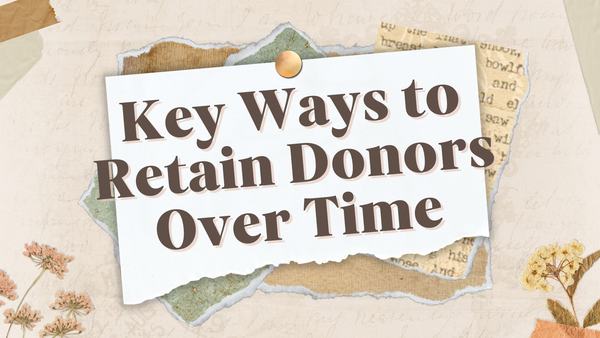Key Ways to Retain Donors Over Time

Key Ways to Retain Donors Over Time
Building Relationships with Donors
Building strong relationships with donors is essential for the long-term sustainability of any nonprofit organization. By focusing on donor retention, nonprofits can significantly increase their impact by maximizing donor lifetime value and fostering a sense of loyalty among supporters. To effectively build relationships with donors, nonprofits should focus on several key strategies. First, personalized communication is crucial in making donors feel valued and appreciated. This can include handwritten letters, personalized emails, or even social media interactions. Nonprofits should also make an effort to stay connected with donors on a regular basis, not just during fundraising campaigns. By sharing updates, success stories, and the positive impact of their donations, nonprofits can keep donors engaged and involved. Additionally, offering special opportunities such as volunteer opportunities or exclusive events can further strengthen the bond between donors and the organization. Finally, regularly expressing gratitude and acknowledging donor contributions is essential in building trust and demonstrating the impact of their support. By implementing these strategies, nonprofits can enhance donor relationships, increase donor retention rates, and ultimately achieve their fundraising goals.
Establishing Meaningful Connections with Donors
Building meaningful connections with donors is a crucial aspect of any successful nonprofit organization. By establishing personal interactions and showing genuine gratitude, nonprofits can cultivate long-term relationships with their supporters.
One effective way to establish these connections is through personal interactions. Taking the time to get to know donors on an individual level allows nonprofits to understand their motivations for supporting the cause. This could be done through phone calls, personalized emails, or even face-to-face meetings. These personal interactions not only make donors feel valued but also create a sense of trust and loyalty.
Expressing gratitude is another key element in building these connections. Thanking donors promptly and sincerely for their contributions is vital to fostering a relationship. Nonprofits can show gratitude in various ways, such as sending handwritten letters, personalized thank-you notes, or even making phone calls. These gestures go a long way in making donors feel appreciated and acknowledged.
In addition to personal interactions and gratitude, sending impact reports can also help establish meaningful connections with donors. These reports highlight specific ways in which their donations have made a difference. By showing the positive impact and outcomes of their contributions, nonprofits are able to reinforce the value of donors' support, leading to increased engagement and loyalty.
Regular communication is also essential in establishing and maintaining connections with donors. Nonprofits can utilize newsletters, monthly reports, or updates on social media platforms to keep donors informed about ongoing projects, events, and success stories. This regular communication not only keeps donors engaged but also demonstrates transparency and accountability.
Developing an Authentic and Personalized Appreciation for Donors
Developing an authentic and personalized appreciation for donors is crucial for nonprofit organizations looking to retain supporters over time. By going beyond a generic "thank you" and truly understanding donors on an individual level, nonprofits can enhance the donor experience and forge stronger relationships.
One key strategy is to understand donor motivations. By taking the time to learn why donors are passionate about a cause, nonprofits can tailor their communication and engagement strategies accordingly. This could involve sending personalized updates or impact reports that align with the donors' specific interests or values.
Engaging donors with positive objective outcomes and storytelling is another effective approach. Nonprofits can highlight the tangible impact of donors' contributions through success stories, testimonials, and case studies. By illustrating the real-world difference that donors' support has made, nonprofits can create a sense of pride and ownership, reinforcing the value of their contributions.
Making donors feel like an important part of the organization's action plan and outcomes is also crucial. Nonprofits can involve donors in decision-making processes, seek their input and feedback, and regularly update them on the progress of ongoing projects. By creating a sense of ownership and involvement, nonprofits can foster a deeper connection with donors, making them feel valued and appreciated.
Utilizing Social Media to Build Relationships with Donors
Social media platforms offer a valuable opportunity for nonprofits to build and maintain relationships with donors. To effectively utilize social media, it is important to focus on donor engagement and provide engaging and informative content that aligns with your organization's mission.
Creating engaging content is crucial in capturing your audience's attention and fostering a connection with donors. Share success stories that showcase the impact of your nonprofit's work and recognize donors for their contributions. By highlighting the tangible results of their support, you can inspire a sense of pride and reinforce the value of their involvement.
Social media also provides a platform to keep donors informed about fundraising efforts. Regularly update your followers on the progress of ongoing campaigns, showcasing how their contributions are making a difference. This transparency and communication help donors feel involved and invested in your organization's mission.
To increase donor engagement on social media, consider interactive campaigns that encourage supporters to share your message. Ask questions, run contests, or invite followers to share their personal stories related to your cause. Active participation not only deepens the connection with donors but also helps expand your reach to potential new supporters.
Crafting Effective Email Communications with Donors
Crafting effective email communications is essential for retaining donors and cultivating stronger relationships. Here are some strategies to consider:
Personalized subject lines: Grab donors' attention by using their name or referencing their past support. Personalization shows that you value their individual contribution and makes them more likely to open the email.
Compelling storytelling: Share impactful stories that demonstrate the positive impact of your organization's work. Use storytelling techniques to connect donors emotionally with the cause and inspire them to continue supporting your mission.
Clear calls to action: Clearly state what action you want donors to take in each email. Whether it's making a donation, attending an event, or volunteering, a strong call to action keeps donors engaged and motivated to contribute.
Segmentation: Segment your donor database based on their preferences, interests, and past giving behavior. This allows you to tailor your email communications to specific groups, increasing their relevance and effectiveness.
Strong opening: Capture donors' attention from the start with a compelling opening that piques their curiosity or offers a sneak peek into the content of the email. An impactful opening ensures that donors continue reading and engaging with the message.
Donor-centric language: Make the email about the donor rather than your organization. Use "you" and "your" language to emphasize their importance and make them feel valued.
Visual elements: Incorporate visually appealing elements like images, infographics, or videos to make your emails more engaging. Visuals can convey information more quickly and leave a lasting impression.
By implementing these strategies, you can create email communications that resonate with donors, drive action, and ultimately retain their support over time.

Utilizing a Database to Manage Existing and Potential Donor Data
Managing donor data is crucial for nonprofit organizations looking to retain donors over time. A comprehensive and well-organized database can provide valuable insights, help track donor interactions, and enable personalized communication strategies. Utilizing our services with DonationXchange can help you to achieve those goals! By effectively utilizing a donor database, nonprofits can strengthen relationships with current donors, target potential donors, and track the success of their fundraising efforts. In this article, we will explore key ways to utilize a database to manage existing and potential donor data, and how this can contribute to a successful donor retention strategy.
Establishing a Database for Existing and New Donor Information
In order to effectively manage donor relationships and retain donors over time, it is crucial for nonprofits to establish a comprehensive database for existing and new donor information. This database serves as a centralized repository for capturing key details and interactions, enabling organizations to cultivate stronger relationships and tailor their communication strategies accordingly.
A well-maintained donor database allows nonprofits to easily access and update donor information, including names, contact details, donation records, volunteer status, and personal interactions. By consistently tracking these details, nonprofits can gain valuable insights into donor preferences, history, and engagement levels. This information is then used to develop personalized donor retention strategies and increase the likelihood of continued support.
One effective strategy to engage different donor groups is through donor segmentation. By categorizing donors according to specific criteria, such as donation amounts, frequency of giving, or event attendance, nonprofits can create targeted communication plans that resonate with each group's interests and motivations. Donor segmentation not only allows organizations to approach their donors on a more personal level but also helps prioritize fundraising efforts and tailor their messaging accordingly.
Segmenting Your Database by Different Types of Gifts, Donation Frequency, and Other Factors
Segmenting your donor database by different types of gifts, donation frequency, and other factors is a powerful strategy to effectively engage and retain donors over time. By categorizing donors based on specific criteria, such as the amount and frequency of their donations, event attendance, or volunteer status, you can create targeted communication plans that resonate with each group's interests and motivations.
Segmenting your donor database allows you to send personalized communication to each group, tailoring your asks and content to their preferences. For example, you can send updates and impact stories to regular donors who contribute on a monthly basis, while reaching out to one-time donors with information about upcoming volunteer opportunities. By understanding the unique characteristics and giving patterns of each segment, you can ensure that your messages are more relevant and compelling.
The benefits of segmenting your donor database are numerous. Firstly, personalized communication helps strengthen donor relationships by making them feel valued and appreciated. Secondly, tailored asks increase the likelihood of donor engagement and subsequent donations. Lastly, segmenting allows you to focus your resources on donors who are most likely to contribute, saving time and effort while maximizing your fundraising efforts.

Maximize Your CSR and Social Impact Programs
DonationXchange robust philanthropy management software helps you streamline administrative tasks and maximize the impact of your donation dollars!
Watch the video:
How DonationXchange Can Help:
• Create & Track Fundraisers, Scholarships, Grants & More!
• Manage & Grow Donor Base
• Process, Track, and Analyze Donation Requests
• Manage Volunteer Opportunities
• Supercharge Employee Engagement
• Champion the Causes that Matter to YOU!
Schedule a demo today!